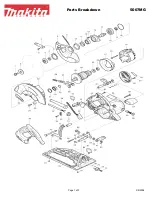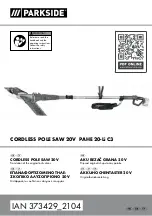
-5-
safety, so the least amount of wheel is
exposed towards the operator.
The guard
helps to protect operator from broken wheel
fragments and accidental contact with wheel.
Wheels must be used only for
recommended applications. For example:
do not grind with the side of cut-off wheel.
Abrasive cut-off wheels are intended for
peripheral grinding, side forces applied to these
wheels may cause them to shatter.
Always use undamaged wheel flanges that
are of correct size and shape for your
selected wheel.
Proper wheel flanges support
the wheel thus reducing the possibility of wheel
breakage. Flanges for cut-off wheels may be
different from grinding wheel flanges.
Do not use worn down wheels from larger
power tools.
Wheel intended for larger power
tool is not suitable for the higher speed of a
smaller tool and may burst.
Additional Safety Warnings Specific for
Abrasive Cutting-Off Operations:
Do not “jam” the cut-off wheel or apply
excessive pressure. Do not attempt to make
an excessive depth of cut.
Overstressing the
wheel increases the loading and susceptibility
to twisting or binding of the wheel in the cut and
the possibility of kickback or wheel breakage.
Do not position your body in line with and
behind the rotating wheel.
When the wheel,
at the point of operation, is moving away from
your body, the possible kickback may propel
the spinning wheel and the power tool directly
at you.
When wheel is binding or when interrupting
a cut for any reason, switch off the power
tool and hold the power tool motionless
until the wheel comes to a complete stop.
Never attempt to remove the cut-off wheel
from the cut while the wheel is in motion
otherwise kickback may occur.
Investigate
and take corrective action to eliminate the
cause of wheel binding.
Do not restart the cutting operation in the
workpiece. Let the wheel reach full speed
and carefully reenter the cut.
The wheel may
bind, walk up or kickback if the power tool is
restarted in the workpiece.
Support panels or any oversized workpiece
to minimize the risk of wheel pinching and
kickback.
Large workpieces tend to sag under
their own weight. Supports must be placed
under the workpiece near the line of cut and
near the edge of the workpiece on both sides of
the wheel.
Use extra caution when making a “pocket
cut” into existing walls or other blind areas.
The protruding wheel may cut gas or water
pipes, electrical wiring or objects that can cause
kickback.
Do not use type 1 abrasive wheels designed
for straight grinding.
Do not attempt to cut large stock or sheets
of metal as this machine is not designed to
be a dedicated cut-off machine.
Safety Warnings Specific for Sanding
Operations:
Do not use excessively oversized sanding
disc paper. Follow manufacturer’s
recommendations, when selecting sanding
paper.
Larger sanding paper extending beyond
the sanding pad presents a laceration hazard
and may cause snagging, tearing of the disc or
kickback.
When connecting tool to dust collection
and extraction systems, be sure these are
connected and used according to tool and
vacuum instructions.
Proper use of dust
collection can reduce dust related hazards.
When using tool with dust collection and
extraction systems, empty the dust
container before beginning work,
frequently during work, after completion of
work, and before storing the tool.
Be
extremely careful of dust disposal, materials in
fine particle form may be explosive.
Do not throw dust on an open fire.
Fine
dust particles may burn explosively.
When performing sanding and surface
preparation operations with tool connected
to a dust collection and extraction system
be aware of the materials creating the dust.
Combustion from mixture of varnishes,
lacquers, polyurethane, oil or water with dust
particles can occur if there is a static
discharge, electric spark, or excessive heat
causing a fire in the dust collection and
extraction system.
DM 2610013190 04-12_DM 2610013190 04-12.qxp 4/10/12 8:05 AM Page 5






































